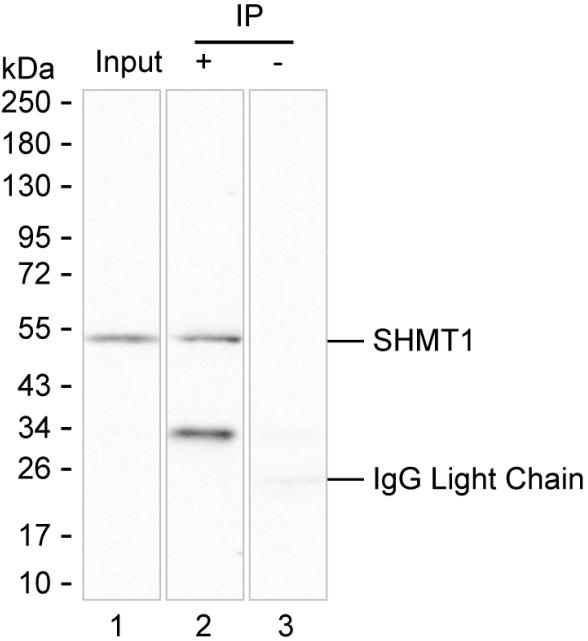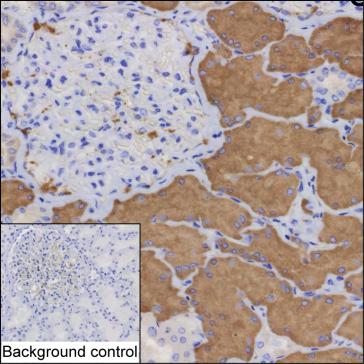

| WB | 咨询技术 | Human,Mouse,Rat |
| IF | 1/100-1/200 | Human,Mouse,Rat |
| IHC | 1/50-1/250 | Human,Mouse,Rat |
| ICC | 技术咨询 | Human,Mouse,Rat |
| FCM | 咨询技术 | Human,Mouse,Rat |
| Elisa | 咨询技术 | Human,Mouse,Rat |
| Host/Isotype | Mouse IgG2a |
| Antibody Type | Primary antibody |
| Storage | Store at 4°C short term. Aliquot and store at -20°C long term. Avoid freeze/thaw cycles. |
| Species Reactivity | Human |
| Immunogen | Purified recombinant fragment of human SHMT1 |
| Formulation | Purified antibody in PBS with 0.05% sodium azide |
+ +
以下是关于SHMT1抗体的3篇参考文献,按文献名称、作者和摘要内容简要概括:
---
1. **文献名称**:*"Serine hydroxymethyltransferase 1 knockdown induces apoptosis in cervical cancer cells through inhibition of mitochondrial biogenesis and ATP production"*
**作者**:Liu Y et al.
**摘要**:该研究通过Western blot和免疫荧光技术,使用SHMT1特异性抗体(来源:兔多克隆抗体,ABCam)验证基因沉默效果,发现SHMT1下调导致宫颈癌细胞线粒体功能受损和凋亡,提示其作为潜在治疗靶点。
---
2. **文献名称**:*"Metabolic role of cytoplasmic SHMT1 in one-carbon metabolism and hepatocellular carcinoma progression"*
**作者**:Jain M et al.
**摘要**:作者利用SHMT1抗体(货号:sc-365092.小鼠单克隆抗体)进行免疫组化分析,发现SHMT1在肝癌组织中高表达,并通过调节一碳代谢促进肿瘤增殖,为代谢重编程研究提供依据。
---
3. **文献名称**:*"Development and validation of a SHMT1-specific polyclonal antibody for functional studies in folate metabolism"*
**作者**:Anderson DD et al.
**摘要**:本文描述了兔源SHMT1多克隆抗体的开发流程,通过ELISA、免疫印迹和免疫沉淀验证其特异性,证明该抗体适用于检测细胞及小鼠模型中SHMT1的表达与功能,支持叶酸代谢相关研究。
---
4. **文献名称**:*"SHMT1 expression correlates with poor prognosis in colorectal cancer: a tissue microarray analysis"*
**作者**:Wang H et al.
**摘要**:研究采用SHMT1抗体(兔源,Cell Signaling Technology)对结直肠癌组织芯片进行染色,结合生存数据分析,发现SHMT1高表达与患者预后不良显著相关,提示其作为生物标志物的潜力。
---
这些文献涵盖了SHMT1抗体在癌症机制、代谢研究和诊断工具开发中的应用,涉及Western blot、免疫组化等技术场景。如需全文链接或补充信息,可进一步提供具体需求。
SHMT1 (Serine Hydroxymethyltransferase 1) is a key metabolic enzyme that catalyzes the reversible conversion of serine and tetrahydrofolate (THF) to glycine and 5.10-methylene-THF. This reaction is critical in one-carbon metabolism, supporting nucleotide synthesis, DNA repair, and methylation processes. SHMT1 is primarily cytosolic and highly expressed in tissues with rapid cell division, such as the liver and certain cancers, making it a focus in oncology and metabolic disease research.
SHMT1 antibodies are essential tools for detecting and quantifying SHMT1 protein levels in various experimental models. They are widely used in techniques like Western blotting, immunohistochemistry (IHC), and immunofluorescence (IF) to study SHMT1's expression patterns, subcellular localization, and regulatory mechanisms. Research has linked SHMT1 dysregulation to cancer progression, folate deficiency disorders, and neural tube defects, underscoring its biomedical relevance.
Commercially available SHMT1 antibodies are typically developed in hosts like rabbits or mice, targeting specific epitopes of human or rodent SHMT1. Validation often includes knockout (KO) cell line controls to ensure specificity. These antibodies aid in exploring SHMT1's role in metabolic adaptation, drug resistance, and as a potential therapeutic target. However, researchers must verify batch consistency and optimize protocols due to variability in antibody performance across applications.
×